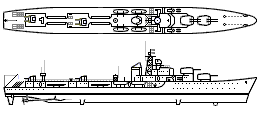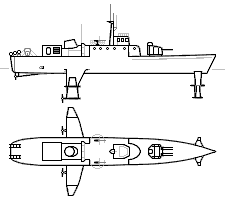Italian Light Cruiser laid down 1932
Displacement:
8,047 t light; 8,400 t standard; 9,777 t normal; 10,879 t full load
Dimensions: Length overall / water x beam x draught
579.02 ft / 557.74 ft x 65.62 ft x 18.70 ft (normal load)
176.48 m / 170.00 m x 20.00 m x 5.70 m
Armament:
16 - 5.98" / 152 mm guns (4x4 guns), 110.23lbs / 50.00kg shells, 1932 Model
Breech loading guns in turrets (on barbettes)
on centreline ends, evenly spread, 2 raised mounts - superfiring
20 - 1.85" / 47.0 mm guns (5x4 guns), 3.86lbs / 1.75kg shells, 1932 Model
Anti-aircraft guns in deck mounts
on side, all forward, 4 raised mounts - superfiring
16 - 0.98" / 25.0 mm guns (8x2 guns), 0.48lbs / 0.22kg shells, 1932 Model
Anti-aircraft guns in deck mounts
on side, all forward, all raised mounts - superfiring
Weight of broadside 1,849 lbs / 838 kg
Shells per gun, main battery: 150
16 - 23.6" / 600 mm above water torpedoes
Armour:
- Belts: Width (max) Length (avg) Height (avg)
Main: 5.39" / 137 mm 328.08 ft / 100.00 m 9.84 ft / 3.00 m
Ends: Unarmoured
Upper: 0.79" / 20 mm 65.62 ft / 20.00 m 8.20 ft / 2.50 m
Main Belt covers 90 % of normal length
- Gun armour: Face (max) Other gunhouse (avg) Barbette/hoist (max)
Main: 5.31" / 135 mm 2.76" / 70 mm 3.94" / 100 mm
2nd: 0.39" / 10 mm 0.39" / 10 mm -
3rd: 0.39" / 10 mm - -
- Armour deck: 1.57" / 40 mm, Conning tower: 5.31" / 135 mm
Machinery:
Oil fired boilers, steam turbines,
Geared drive, 2 shafts, 62,000 shp / 46,252 Kw = 30.53 kts
Range 2,512nm at 28.00 kts
Bunker at max displacement = 2,478 tons
Complement:
491 - 639
Cost:
£3.297 million / $13.187 million
Distribution of weights at normal displacement:
Armament: 223 tons, 2.3 %
Armour: 1,961 tons, 20.1 %
- Belts: 780 tons, 8.0 %
- Torpedo bulkhead: 0 tons, 0.0 %
- Armament: 390 tons, 4.0 %
- Armour Deck: 739 tons, 7.6 %
- Conning Tower: 52 tons, 0.5 %
Machinery: 1,830 tons, 18.7 %
Hull, fittings & equipment: 3,865 tons, 39.5 %
Fuel, ammunition & stores: 1,730 tons, 17.7 %
Miscellaneous weights: 168 tons, 1.7 %
Overall survivability and seakeeping ability:
Survivability (Non-critical penetrating hits needed to sink ship):
14,281 lbs / 6,478 Kg = 133.3 x 6.0 " / 152 mm shells or 2.1 torpedoes
Stability (Unstable if below 1.00): 1.09
Metacentric height 3.1 ft / 0.9 m
Roll period: 15.6 seconds
Steadiness - As gun platform (Average = 50 %): 70 %
- Recoil effect (Restricted arc if above 1.00): 0.40
Seaboat quality (Average = 1.00): 1.01
Hull form characteristics:
Hull has rise forward of midbreak
and transom stern
Block coefficient: 0.500
Length to Beam Ratio: 8.50 : 1
'Natural speed' for length: 27.31 kts
Power going to wave formation at top speed: 57 %
Trim (Max stability = 0, Max steadiness = 100): 69
Bow angle (Positive = bow angles forward): 30.00 degrees
Stern overhang: 3.28 ft / 1.00 m
Freeboard (% = measuring location as a percentage of overall length):
- Stem: 31.17 ft / 9.50 m
- Forecastle (22 %): 21.33 ft / 6.50 m
- Mid (52 %): 21.33 ft / 6.50 m (13.12 ft / 4.00 m aft of break)
- Quarterdeck (19 %): 13.12 ft / 4.00 m
- Stern: 13.12 ft / 4.00 m
- Average freeboard: 18.25 ft / 5.56 m
Ship space, strength and comments:
Space - Hull below water (magazines/engines, low = better): 81.0 %
- Above water (accommodation/working, high = better): 105.2 %
Waterplane Area: 25,357 Square feet or 2,356 Square metres
Displacement factor (Displacement / loading): 129 %
Structure weight / hull surface area: 106 lbs/sq ft or 517 Kg/sq metre
Hull strength (Relative):
- Cross-sectional: 0.97
- Longitudinal: 1.31
- Overall: 1.00
Hull space for machinery, storage, compartmentation is excellent
Room for accommodation and workspaces is adequate
Ship has slow, easy roll, a good, steady gun platform
48t = 16x600mm torpedoes
80t = 5x quadruple 47mm mounts
40t = 25mm deck over torpedoes
Belt is like Abruzzi, 30+100@12°






Quoted
I think RA said the new 1932 model ACRs were a little smaller than the previous model, so they might actually BE Treaty cruisers, rather than capital ships.Quoted
I´d probably raise the CLs bridge by one deck level but that just nit picking. :o)Quoted
You have a ship designed to run at very high speeds, given great flexibility, but that even if optimized will use a large amount of fuel/hour. As an economic concern, won't that be terribly expensive to operate in peacetime and a supply burden in wartime?